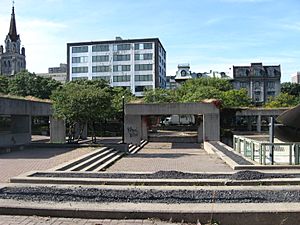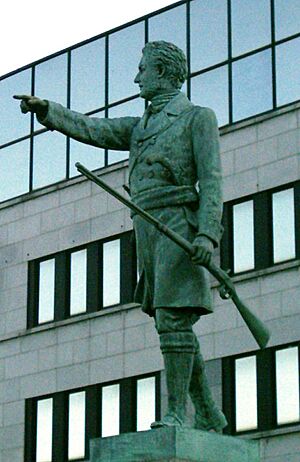Viger Square facts for kids
Quick facts for kids Viger SquareFrench: Square Viger |
|
|---|---|

Agora by Charles Daudelin is a prominent sculpture in Viger Square.
|
|
| Lua error in Module:Location_map at line 420: attempt to index field 'wikibase' (a nil value). | |
| Type | Town square |
| Location | Old Montreal, Ville-Marie Montreal, Quebec, Canada |
| Created | September 11, 1860 |
| Operated by | City of Montreal |
| Status | Open all year |
Viger Square is a public space in Montreal, Quebec, Canada. It's officially known as French: square Viger in French. This square looks very different today because a big highway, the Ville-Marie Expressway, was built underneath it in the 1970s. The square is split into three parts. It is surrounded by Saint Denis Street to the west, Saint André Street to the east, Viger Street to the north, and Saint Antoine Street to the south.
Contents
History of Viger Square
In the 1840s, the city of Montreal bought some wet, swampy land to build Viger Square. They planted trees and made paths for people to walk on.
Before 1851, this area was a busy place. There was a market where people sold hay, and a public scale to weigh goods. These were located on the east side of Saint Denis Street. The hay market moved around a bit, but always stayed on the east side.
Viger Square officially opened on September 11, 1860. A few years later, in 1865, greenhouses were added to the square. However, these greenhouses were later moved to La Fontaine Park in 1889.
In 1870, Viger Square was the only public spot in Montreal where you could listen to live music. A famous conductor named Ernest Lavigne led his orchestra in Viger Square from 1885 to 1889. He later moved his concerts to Sohmer Park.
Expanding the Square
In 1892, people wanted the square to be bigger. So, a cattle market nearby was torn down to make more space. Around this time, some important French-Canadian families moved close to the square. This made the area very popular. New, fancy buildings were built, like Place Viger in 1898 and the École des hautes études commerciales (a business school) between 1908 and 1910.
Changes in the 20th Century
In the middle of the 1900s, many ideas were suggested for Viger Square. Some people wanted to build a city library there. Others thought about an auditorium to celebrate Montreal's 300th birthday in 1942. In the 1950s, there was even a plan to turn it into a large parking lot.
The Highway's Impact
However, it was the building of new roads that changed the square the most. The original park was destroyed when the Ville-Marie Expressway was built underground in the 1970s. After the highway was finished, a new Viger Square was created on top of its concrete roof. This new square was made in three sections.
Artists helped design these new sections. Sculptors Charles Daudelin, Claude Théberge, and Peter Gnass worked on the square. The new Viger Square was completed in 1985.
Future Plans for Viger Square
Today, Viger Square looks very different from its past. Some people criticize it because it has a lot of concrete structures. Also, there are often people experiencing homelessness in the area.
A big new hospital project, the Centre hospitalier de l'Université de Montréal, is being built nearby. This project will bring many changes to the neighborhood. There will be public meetings where people can share their ideas. These ideas will help decide how Viger Square will be redesigned in the future.
Jean-Olivier Chénier Monument
The Jean-Olivier Chénier Monument is a memorial statue. It was designed by Alfonso Pelzer and is located on Saint Denis Street, right across from Viger Square. A group formed in 1893 approved the monument on April 24, 1895. It stands about 4.33 meters (14.2 feet) tall and is made from pink granite, bronze, and copper.
Sculptures in Viger Square
Viger Square is home to several interesting sculptures:
- Agora (1983), by Charles Daudelin
- Mastodo (a fountain sculpture) (1984), also by Charles Daudelin
- Force (a fountain sculpture) (1985), by Claude Théberge
- Jeux d'enfants (a fountain sculpture, meaning "Children's Games") (1984), by Peter Gnass



